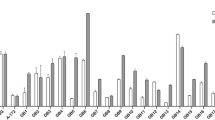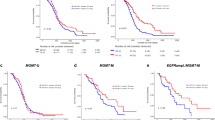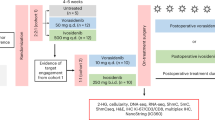Abstract
Glioblastoma multiforme is the most common primary brain tumor in adults. Until recently, the standard of care consisted of maximal surgical resection followed by external beam radiotherapy. The role of adjuvant chemotherapy for newly diagnosed glioblastoma has been controversial; most of the numerous randomized phase III trials conducted over the past 40 years have failed to show a statistically significant and clinically meaningful survival advantage for patients randomized to the chemotherapy arm. Consequently, the choices of chemotherapeutics for patients with glioblastoma have been limited, and cytotoxic treatment regimens have usually included a nitrosourea. Temozolomide, a relatively new orally administered methylating agent, has demonstrable activity in glioma. A recent trial conducted under the auspices of the European Organization for the Research and Treatment of Cancer (EORTC) and National Cancer Institute of Canada Clinical Trials Group (NCIC CTG) has defined a role for temozolomide in the initial management of glioblastoma. A companion correlative tumor-biology study has identified epigenetic silencing of the promoter of the gene that encodes MGMT (O6-methylguanine-DNA methyltransferase) in tumor specimens as a strong and independent prognostic factor for survival among patients with a newly diagnosed glioblastoma, as well as a predictor of survival benefit from chemoradiotherapy with temozolomide. This review briefly summarizes the development of temozolomide as a therapy for patients with malignant brain tumors, emphasizing recent trials that have established a new standard of care for patients with glioblastoma and speculating on how these advances might influence future therapeutic investigations for malignant primary brain tumors.
Key Points
-
Glioblastoma multiforme is the most common primary brain tumor in adults, but there are limited chemotherapeutic options for patients with this condition
-
The orally administered methylating agent temozolomide has demonstrable activity in glioma, and a recent trial has defined a role for this drug in the initial management of glioblastoma
-
Temozolomide resistance is mediated by two distinct repair mechanisms: the MGMT (O6-methylguanine-DNA methyltransferase) suicide protein and DNA mismatch repair
-
MGMT promoter methylation is associated with superior survival in patients who receive combined temozolomide and radiotherapy for glioblastoma
-
The addition of temozolomide concurrently with radiotherapy—and adjuvantly thereafter—for newly diagnosed glioblastoma will undoubtedly become the new standard of care for most patients with this illness
This is a preview of subscription content, access via your institution
Access options
Subscribe to this journal
Receive 12 print issues and online access
$209.00 per year
only $17.42 per issue
Buy this article
- Purchase on Springer Link
- Instant access to full article PDF
Prices may be subject to local taxes which are calculated during checkout


Similar content being viewed by others
References
DeAngelis L (2001) Brain tumors. N Engl J Med 344: 114–123
Burger P and Scheithauer B (1994) Tumors of the Central Nervous System. Washington, DC: Armed Forces Institute of Pathology
Cairncross G et al. (1994) Chemotherapy for anaplastic oligodendroglioma. J Clin Oncol 12: 2013–2021
Fortin D et al. (1999) Oligodendroglioma: an appraisal of recent data pertaining to diagnosis and treatment. Neurosurgery 45: 1279–1291
Chang C et al. (1983) Comparison of postoperative radiotherapy and combined postoperative radiotherapy and chemotherapy in the multidisciplinary management of malignant gliomas. Cancer 52: 997–1007
Medical Research Council Brain Tumor Working Party (2001) Randomized trial of procarbazine, lomustine, and vincristine in the adjuvant treatment of high-grade astrocytoma: a Medical Research Council trial. J Clin Oncol 19: 509–518
Shapiro W et al. (1989) Randomized trial of three chemotherapy regimens and two radiotherapy regimens in postoperative treatment of malignant glioma. J Neurosurg 71: 1–9
Walker M et al. (1978) Evaluation of BCNU and/or radiotherapy in the treatment of anaplastic gliomas. J Neurosurg 49: 333–343
Walker M et al. (1980) Randomized comparison of radiotherapy and nitrosoureas for the treatment of malignant glioma after surgery. N Engl J Med 303: 1323–1329
Stewart L (2002) Chemotherapy in adult high-grade glioma: a systematic review and meta-analysis of individual patient data from 12 randomized trials. Lancet 359: 1011–1018
Newlands E et al. (1997) Temozolomide: a review of its discovery, chemical properties, pre-clinical development and clinical trials. Cancer Treat Rev 23: 35–61
Stupp R et al. (2001) Current and future developments in the use of temozolomide for the treatment of brain tumors. Lancet Oncol 2: 552–560
Ostermann S et al. (2004) Plasma and cerebrospinal fluid population pharmacokinetics of temozolomide in malignant glioma patients. Clin Cancer Res 10: 3728–3736
Yung WKA et al. (2000) A phase II study of temozolomide versus procarbazine in patients with glioblastoma multiforme at first relapse. Br J Cancer 85: 588–593
Yung WKA et al. (1999) Multicenter phase II trial of temozolomide in patients with anaplastic astrocytoma or anaplastic oligoastrocytoma at first relapse. J Clin Oncol 17: 2762–2771
Brada M et al. (2001) Multicenter phase II trial of temozolomide in patients with glioblastoma multiforme at first relapse. Ann Oncol 12: 259–266
Newlands ES et al. (1996) The Charing Cross Hospital experience with temozolomide in patients with gliomas. Eur J Cancer 32A: 2236–2241
Stupp R et al. (2005) Radiotherapy plus concomitant and adjuvant temozolomide for newly diagnosed glioblastoma. N Engl J Med 352: 987–996
Newlands E et al. (1992) Phase I trial of temozolomide (CCRG 81045: M and B 39831: NSC 362856). Br J Cancer 65: 287–291
Clark A et al. (1995) Anti-tumor imidazotetrazines: synthesis of novel imidazotetrazines and related bicyclic heterocycles to probe the mode of action of the antitumor drug temozolomide. J Med Chem 38: 1493–1504
Denny B et al. (1994) NMR and molecular modeling investigation of the mechanism of activation of the antitumor drug temozolomide and its interaction with DNA. Biochemistry 33: 9045–9051
Brada M et al. (1999) Phase I dose-escalation and pharmacokinetic study of temozolomide (SCH 52365) for refractory or relapsing malignancies. Br J Cancer 81: 1022–1030
Figueroa J et al. (2000) Protracted cyclic administration of temozolomide is feasible: a phase I and pharmacokinetic-pharmacodynamic study [abstract #868]. Proc Am Soc Clin Oncol 19: 22a
Brock C et al. (1998) Phase I trial of temozolomide using an extended continuous oral schedule. Cancer Res 58: 4363–4367
Tolcher A et al. (2003) Marked inactivation of O6-alkylguanine-DNA alkyltransferase activity with protracted temozolomide schedules. Br J Cancer 88: 1004–1011
Osoba D et al. (2000) Health-related quality of life in patients treated with temozolomide versus procarbazine for recurrent glioblastoma multiforme. J Clin Oncol 18: 1481–1491
Friedman H et al. (1998) DNA mismatch repair and O6-alkylguanine-DNA alkyltransferase analysis and response to Temodal in newly diagnosed malignant glioma. J Clin Oncol 16: 3851–3857
Gilbert M et al. (2000) Preradiation treatment of newly diagnosed anaplastic astrocytomas and glioblastoma multiforme using temozolomide [abstract #77]. Neuro-oncol 2: a264
van Rijn J et al. (2000) Survival of human glioma cells treated with various combinations of temozolomide and X-rays. Int J Radiat Oncol Biol Phys 47: 779–784
Wedge S et al. (1997) In vitro evaluation of temozolomide combined with X-irradiation. Anticancer Drugs 8: 92–97
Wick W et al. (2002) Prevention of irradiation-induced glioma cell invasion by temozolomide involves caspase 3 activity and cleavage of focal adhesion kinase. Cancer Res 62: 1915–1919
Stupp R et al. (2002) Promising survival for patients with newly diagnosed glioblastoma multiforme treated with concomitant radiation plus temozolomide followed by adjuvant temozolomide. J Clin Oncol 20: 1375–1382
Esteller M et al. (2000) Inactivation of the DNA-repair gene MGMT and the clinical response of gliomas to alkylating agents. N Engl J Med 343: 1350–1354
Jaeckle K et al. (1998) Correlation of tumor O6 methylguanine-DNA methyltransferase levels with survival of malignant astrocytoma patients treated with bis-chloroethylnitrosourea: a Southwest Oncology Group study. J Clin Oncol 16: 3310–3315
Esteller M et al. (1999) Inactivation of the DNA repair gene O6-methylguanine-DNA methyltransferase by promotor hypermethylation is a common event in primary human neoplasia. Cancer Res 59: 793–797
Hegi M et al. (2004) Clinical trial substantiates the predictive value of O-6-methylguanine-DNA methyltransferase promotor methylation in glioblastoma patients treated with temozolomide. Clin Cancer Res 10: 1871–1874
Hegi M et al. (2005) MGMT gene silencing and benefit from temozolomide in glioblastoma. N Engl J Med 352: 997–1003
Roa W et al. (2004) An abbreviated course of radiation therapy in older patients with glioblastoma multiforme: A prospective randomized clinical trial. J Clin Oncol 22: 1583–1588
Brandes A et al. (2003) A prospective study on glioblastoma in the elderly. Cancer 97: 657–662
Cairncross JG et al. (1998) Specific genetic predictors of chemotherapeutic response and survival in patients with anaplastic oligodendrogliomas. J Natl Cancer Inst 90: 1473–1479
van den Bent M et al. (2003) Recent developments in the molecular characterization and treatment of oligodendroglial tumors. Neuro-oncol 5: 128–138
Ino Y et al. (2001) Molecular subtypes of anaplastic oligodendroglioma: implications for patient management at diagnosis. Clin Cancer Res 7: 839–845
van den Bent M et al. (2005) First analysis of EORTC trial 26951, a randomized phase III study of adjuvant PCV chemotherapy in patients with highly anaplastic oligodendroglioma [abstract #1503]. Proc Am Soc Clin Oncol 23: a115s
Cairncross G et al. (2004) An intergroup randomized controlled clinical trial (RTC) of chemotherapy plus radiation (RT) versus RT alone for pure and mixed anaplastic oligodendrogliomas: Initial report of RTOG 94-02. J Clin Oncol 22 (Suppl): S1500
Author information
Authors and Affiliations
Corresponding author
Ethics declarations
Competing interests
Warren Mason is a speaker and consultant for Schering-Plough—the manufacturers of temozolamide. J Gregory Cairncross has received honoraria from and has participated in advisory boards for Schering-Plough.
Rights and permissions
About this article
Cite this article
Mason, W., Cairncross, J. Drug Insight: temozolomide as a treatment for malignant glioma—impact of a recent trial. Nat Rev Neurol 1, 88–95 (2005). https://doi.org/10.1038/ncpneuro0045
Received:
Accepted:
Issue Date:
DOI: https://doi.org/10.1038/ncpneuro0045
This article is cited by
-
Therapeutic strategies of drug repositioning targeting autophagy to induce cancer cell death: from pathophysiology to treatment
Journal of Hematology & Oncology (2017)
-
Identification of thioridazine, an antipsychotic drug, as an antiglioblastoma and anticancer stem cell agent using public gene expression data
Cell Death & Disease (2015)
-
Temozolomide use in adult patients with gliosarcoma: an evolving clinical practice
Journal of Neuro-Oncology (2013)
-
Triptolide inhibits proliferation and invasion of malignant glioma cells
Journal of Neuro-Oncology (2012)
-
Total dietary antioxidant index and survival in patients with glioblastoma multiforme
Cancer Causes & Control (2009)



